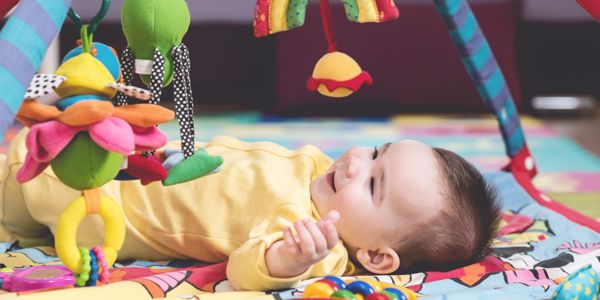Vision is the most complex sensory system in the human body, yet the least mature at birth. Though newborns have the anatomical structures needed for sight, it takes infants time and exposure to visual stimuli to learn and develop the properties necessary for full calibration of their visual system. Children gain visual perception and more refined acuity of vision over the course of many months, often at varying rates depending on stimuli.
The neurological connections of your baby’s developing vision become functional not long after birth. Visual stimulation – shapes, colours, patterns and varying light intensity – helps aid the development of the lateral geniculate nucleus (helping to focus the baby’s attention on important information) and the striate cortex (a growing child’s main receiving area for visual signals) in the first few months of life.
Your newborn’s visual acuity improves quickly through the first year of life before slowing gradually. Children reach full maturity of their developing vision at five or six years old. A typical child will not approach 20/20 vision until six to 30 months of age. A child’s foveal cones (the part of the eye that controls fine vision) do not reach adult appearance until four months after term birth, and visual pathways continue to develop until approximately two years of age.
Children deprived of visual stimulation may have lasting neurological deficits and face disadvantages in many areas of development. Babies that receive powerful visual stimulation from colours, shapes and patterns show more robust brain growth and faster visual development. They also experience improved physical, emotional and cognitive development, which helps promote curiosity and an interest in exploring their world.
The Effect of Colours on Emotional and Intellectual Development
Research by Daggett and Cobble (2008) found that colours stimulate or reduce hormone production and alpha brain wave activity, producing strong psychological and physiological influences, especially on emotions and feelings.
As babies develop, they rely on exposure to visual stimuli and cues to aid memory. Familiar visual stimuli are beneficial in reassuring a baby, and more distinctive visual stimuli provide specific cues and associations. These distinctive and familiar visual stimuli have powerfully emotional and lasting effects.
Visual Stimulus in Developing Creativity and Learning
Giving young children access to activities and objects rich in creative and imaginative opportunities will promote skills, attitudes and knowledge and will benefit their learning and development.
As children grow into the early preschool years, maturation of visual acuity helps to refine the hand, eye, and body coordination and fine motor skills necessary to begin reading. Children can follow along as their parents read, pointing out the words for the children to follow along. The process of learning, creativity, and even emotional well being in babies and toddlers traces back to visual development, reinforced by shapes, colours, and visual stimuli.






